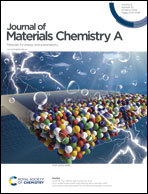Ultrafast and highly selective gold recovery with high capture capacity from electronic waste by upconversion of a silsesquioxane-based hybrid luminescent aerogel†
Abstract
To maintain sustainable development and improve resource utilization, there is an urgent need to recover gold using an eco-friendly, efficient and highly-selective method. We describe here, a silsesquioxane-based hybrid luminescent porous polymer (PCS-CZ-B-DCM) with high surface area synthesized by Friedel–Crafts reaction of octavinylsilsesquioxane (OVS) with 4-(dicyanomethylene)-2,6-bis(4-(carbazolo-9-yl)phenyl)-4H-pyran. Then, a hybrid aerogel (PCSs@chitosan) was prepared by covalently crosslinking a thiol-attached chitosan binder with retained vinyls in PCS-CZ-B-DCM via a thiol–ene reaction under UV irradiation. The PCSs@chitosan offers highly selective detection of Au(III) at a detection limit of ≈7 ppb. Furthermore, it absorbs Au(III) rapidly with a high adsorption rate under visible light illumination reaching a gold capacity of 3300 ± 30 mg g−1 in 5 min. Finally, a visible-light-driven PCSs@chitosan-based continuous-flow glass device was fabricated to recover a large amount of gold (38 mg) with 23.8 ct purity from e-wastewater in as little as 2 min at 150 mL min−1.



 Please wait while we load your content...
Please wait while we load your content...